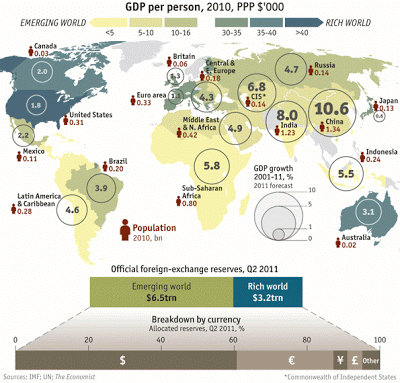1. The shift in economic power from West to East is accelerating, says John O’Sullivan. The “great divergence” (industrialization and mass production) between the West and the rest lasted for two centuries.
A “great convergence” in living standards is under way as poorer countries speedily adopt the technology, know-how and policies that made the West rich. China and India are the biggest and fastest-growing of the catch-up countries, but the emerging-market boom has spread to embrace Latin America and Africa, too.
By 2013 emerging markets (on the IMF’s definition) will produce more than half of global output, measured at purchasing-power parity (PPP).
According to the University of Pennsylvania, China’s per capita PPP GDP in 2009 was $8500 to $9200. If Pennworld tables are correct then per capita GDP in 2011 is $10400 to $11300 in 2011 in China and will be $11300 to $12300 in 2012.
2. The International Monetary Fund cut its forecast for global growth to 4% and warned of “severe repercussions” to the global economy unless euro-zone nations strengthen their banking system and the U.S. gets its fiscal affairs in order.
The IMF reduced its estimate of global growth by 0.3 percentage point since its most recent estimate in June. For 2012, the IMF forecast world growth would remain steady at 4%, a 0.5-percentage-point reduction from its June estimate. Wealthy nations especially are struggling, said the IMF, which forecast the U.S. will grow 1.5% this year, only slightly less than the euro zone, at 1.6%. The IMF expects Japan’s economy to contract 0.5% this year.
Growth in developing countries is likely to be much stronger—though still not as strong as it was in 2010. China is expected to grow 9.5% this year, compared with 10.3% in 2010, the IMF said, while India’s growth is forecast to slow to 7.8% this year from 10.1% in 2010.
If you liked this article, please give it a quick review on ycombinator or StumbleUpon. Thanks

Brian Wang is a Futurist Thought Leader and a popular Science blogger with 1 million readers per month. His blog Nextbigfuture.com is ranked #1 Science News Blog. It covers many disruptive technology and trends including Space, Robotics, Artificial Intelligence, Medicine, Anti-aging Biotechnology, and Nanotechnology.
Known for identifying cutting edge technologies, he is currently a Co-Founder of a startup and fundraiser for high potential early-stage companies. He is the Head of Research for Allocations for deep technology investments and an Angel Investor at Space Angels.
A frequent speaker at corporations, he has been a TEDx speaker, a Singularity University speaker and guest at numerous interviews for radio and podcasts. He is open to public speaking and advising engagements.


